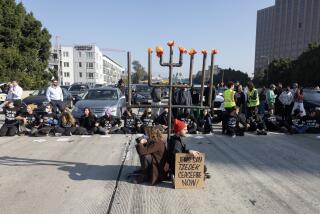Forgotten Victims of the Riots and Videotape
- Share via
I stood there, covered in the required hospital robe and surgical mask, looking down at Wallace Tope. His long, pale body lay awkwardly on one side, silhouetted against the deep-blue hospital sheets. He was motionless, except for the rise and fall of his chest from breathing. Dishwater-blue eyes beneath drooping eyelids stared blankly into space. I had never seen anyone in a coma before.
To the right of his bed, friends had left a legal pad for visitors to sign and leave their thoughts. There was a gospel hymnbook, a Bible and a prayer manual stacked neatly beside it. Nobody else was present--just me and a dying man alone in a hospital room. And then my mind flashed to a puzzling question I first faced in high school.
“If a tree falls in the forest and no one is there to hear it, does it make a sound? “
*
Tope has been like this for more than a year. You probably don’t recognize the name, just like you probably don’t recognize the names Howard Epstein, Arturo Miranda, Eduardo Vela, John H. Willers, Ira McCurry, Thanh Lam, Patrick Bettan, Matthew Haines, Adolfo Morales, Jamie Harris and Kevin Evanshen.
Tope, a 51-year-old street preacher, lapsed into a coma after he was beaten by looters outside a Hollywood store on the second day of the riots that followed the Simi Valley verdicts in the Rodney G. King beating trial. Doctors don’t expect him to recover.
Those other names are of people who were murdered or otherwise died during those hellish four days. There are at least 51 riot-related deaths.
But you probably wouldn’t know any of them, either. When we think of riot victims, only one name comes to mind--Reginald Denny.
I was considering why that was when I pulled into the parking lot of a liquor store at 102nd and Avalon. I was trying to find somebody who knew Ira McCurry, a 45-year-old, white, golf course maintenance worker who lived next door and who had tried the first night of the riots to persuade looters not to burn the store.
They didn’t burn it. They shot and killed McCurry instead.
I asked the two men behind the liquor store counter, one Asian, the other black, if they knew in exactly which house McCurry lived. I explained the circumstances of his death.
“Never heard of him,” the Asian man said.
His co-worker looked at me blankly and shook his head.
*
There are some guidelines the media use to determine which stories deserve the most attention. One of them is called impact.
There are a few exceptions, but it generally goes like this: If 100 people get killed, that takes precedence over a story about 10 people getting killed, which takes precedence over a story about one person getting killed, which takes precedence over a story about one person getting shot and so on.
Then why wasn’t Wallace Tope or Ira McCurry as big a story as Reginald Denny? For that matter, what about Matthew Haines?
The first night of the riots, Haines and his nephew, Scott Baldwin, were pulled off their motorcycles in Long Beach, beaten and shot. Haines died. Baldwin, shot five times, no longer has the use of one arm.
Police arrested eight suspects, there was a trial and six were convicted and sentenced to prison, but people hardly noticed. All the public wanted to hear about was Reginald Denny.
I was fumbling through those thoughts outside a little jazz and coffeehouse over in Leimert Village named Fifth Street Dick’s when the subject of the Denny trial came up--again.
“It’s the video, Ron,” explained owner Richard Fulton as we sipped his special house blend of African coffee. “If it hadn’t been for the video, nobody would really give a damn about Denny. He didn’t suffer any more than all those other people.
“It was the same thing with Rodney King. You know, I know, everybody knows that black folks have been hollering and complaining about police brutality for years. But it didn’t matter until it was on video. Now the white folks have got a video, and that’s all they see.”
That also must be the difference between John L. Daniels Jr. and Rodney King. Daniels, a tow truck driver, was killed by a police officer at Florence and Crenshaw two months after the riots. The officer, Douglas Iverson, has been charged with murder. There have been no rallies, no cries of outrage, no major public statements or press conferences from the Police Department. Unlike King, Daniels won’t be around to sue the city and possibly collect millions.
” . . . If nobody is there to hear it. . . . “
If people are maimed and murdered or assaulted by police or an angry mob, and there are no video cameras around to record the events, did they really happen? Or more significantly, does anyone really care?
More to Read
Sign up for Essential California
The most important California stories and recommendations in your inbox every morning.
You may occasionally receive promotional content from the Los Angeles Times.










